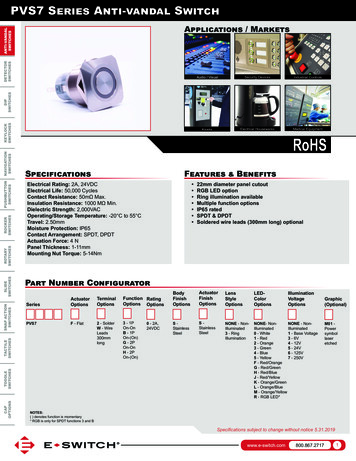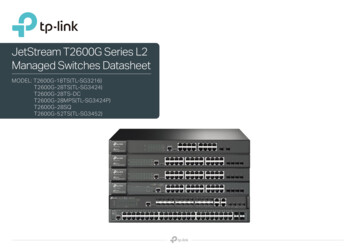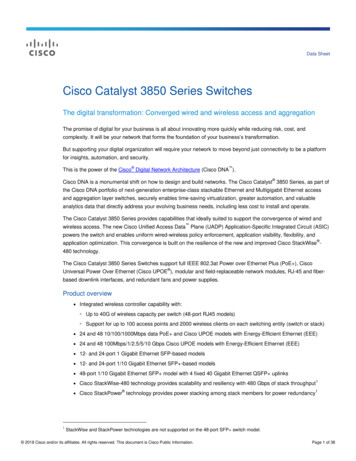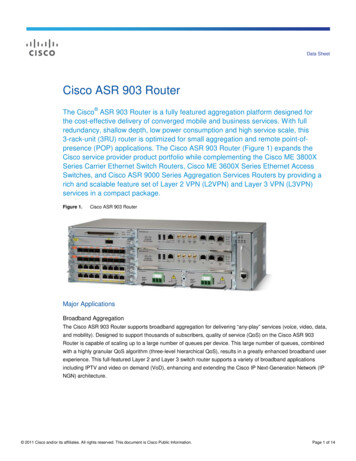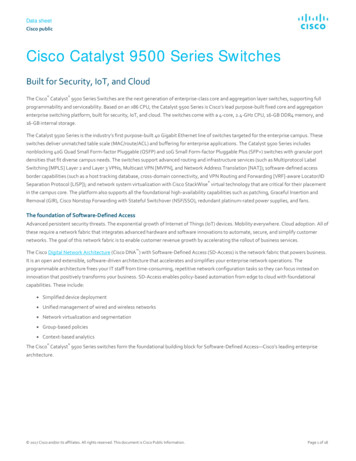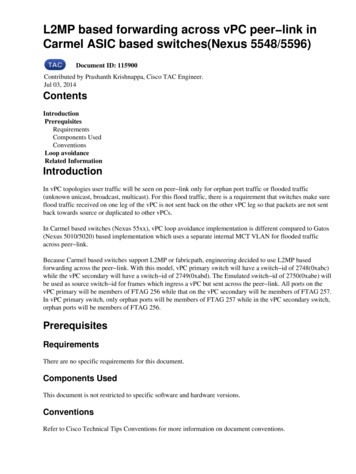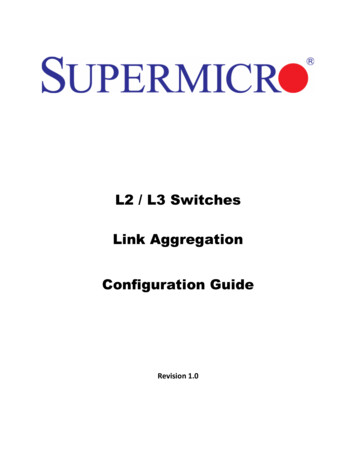
Transcription
L2 / L3 SwitchesLink AggregationConfiguration GuideRevision 1.0
Link Aggregation Configuration GuideThe information in this USER’S MANUAL has been carefully reviewed and is believed to be accurate. The vendorassumes no responsibility for any inaccuracies that may be contained in this document, makes no commitment toupdate or to keep current the information in this manual, or to notify any person or organization of the updates.Please Note: For the most up-to-date version of this manual, please see our web site at www.supermicro.com.Super Micro Computer, Inc. (“Supermicro”) reserves the right to make changes to the product described in thismanual at any time and without notice. This product, including software, if any, and documentation may not, inwhole or in part, be copied, photocopied, reproduced, translated or reduced to any medium or machine withoutprior written consent.IN NO EVENT WILL SUPERMICRO BE LIABLE FOR DIRECT, INDIRECT, SPECIAL, INCIDENTAL, SPECULATIVE ORCONSEQUENTIAL DAMAGES ARISING FROM THE USE OR INABILITY TO USE THIS PRODUCT OR DOCUMENTATION,EVEN IF ADVISED OF THE POSSIBILITY OF SUCH DAMAGES. IN PARTICULAR, SUPERMICRO SHALL NOT HAVELIABILITY FOR ANY HARDWARE, SOFTWARE, OR DATA STORED OR USED WITH THE PRODUCT, INCLUDING THECOSTS OF REPAIRING, REPLACING, INTEGRATING, INSTALLING OR RECOVERING SUCH HARDWARE, SOFTWARE, ORDATA.Any disputes arising between manufacturer and customer shall be governed by the laws of Santa Clara County inthe State of California, USA. The State of California, County of Santa Clara shall be the exclusive venue for theresolution of any such disputes. Super Micro's total liability for all claims will not exceed the price paid for thehardware product.FCC Statement: This equipment has been tested and found to comply with the limits for a Class A digital devicepursuant to Part 15 of the FCC Rules. These limits are designed to provide reasonable protection against harmfulinterference when the equipment is operated in a commercial environment. This equipment generates, uses, andcan radiate radio frequency energy and, if not installed and used in accordance with the manufacturer’s instructionmanual, may cause harmful interference with radio communications. Operation of this equipment in a residentialarea is likely to cause harmful interference, in which case you will be required to correct the interference at yourown expense.California Best Management Practices Regulations for Perchlorate Materials: This Perchlorate warning applies onlyto products containing CR (Manganese Dioxide) Lithium coin cells. Perchlorate Material-special handling mayapply. See http://www.dtsc.ca.gov/hazardouswaste/perchlorate/ for further details.Manual Revision 1.0Release Date: January 25, 2013Unless you request and receive written permission from Super Micro Computer, Inc., you may not copy any part ofthis document.Information in this document is subject to change without notice. Other products and companies referred toherein are trademarks or registered trademarks of their respective companies or mark holders.Copyright 2013 by Super Micro Computer, Inc.All rights reserved.Printed in the United States of AmericaSupermicro L2/L3 Switches Configuration Guide2
Link Aggregation Configuration GuideContents1Link Aggregation Configuration Guide . 41.1Link Aggregation Basics . 41.2Link Aggregation Support. 51.3Link Aggregation Numbers. 61.4Link Aggregation Defaults . 61.5Static Link Aggregation. 61.6Dynamic Link Aggregation - LACP . 61.7Creating Port Channels . 81.7.1Creating Port Channel Interfaces . 81.7.2Adding Member Ports to Port Channels . 91.8Modifying Port Channels. 111.8.1Modifying Port Channel Parameters. 111.8.2Modifying Port Channel Member Ports . 111.9Removing Port Channels . 141.10LACP Parameters . 151.10.1LACP System Priority . 161.10.2LACP Port Priority . 161.10.3LACP Timeout . 181.10.4LACP Wait Time . 191.11Load Balancing . 201.12Disabling Link Aggregation Feature . 221.13Link Aggregation Configuration Example . 23Supermicro L2/L3 Switches Configuration Guide3
Link Aggregation Configuration Guide1 Link Aggregation Configuration GuideThis document describes the Link Aggregation feature supported in Supermicro Layer 2 / Layer 3 switchproducts.This document covers the Link Aggregation configurations for the below listed Supermicro switchProducts.Top of Rack SwitchesBlade Switches SSE-G24-TG4 SSE-G48-TG4 SSE-X24S SSE-X3348S SSE-X3348T SBM-GEM-X2C SBM-GEM-X2C SBM-GEM-X3S SBM-XEM-X10SMThe majority of this document applies to the above listed Supermicro switch products. In any particularsub section however, the contents might vary across these switch product models. In those sections thedifferences are clearly identified with reference to particular switch product models. If any particularswitch product model is not referenced, the reader can safely assume that the content is applicable toall the above listed models.Throughout this document, the common term “switch” refers to any of the above listedSupermicro switch product models unless a particular switch product model is noted.1.1 Link Aggregation BasicsThe Link Aggregation feature when helps connecting two or more physical links between two networkdevices without forming loops. Link Aggregation can be used between switches, servers and routers.Link Aggregation provides the following advantages:Supermicro L2/L3 Switches Configuration Guide4
Link Aggregation Configuration Guide Increased bandwidth – User can connect up to eight physical links between devices to increasethe link bandwidth. When 1 Gbps links are aggregated, users can get an aggregated link with upto 8 Gbps bandwidth . In 10Gig switches, user can aggregate eight 10Gig ports to get up to 80Gbps speed aggregated uplink. Incremental bandwidth – Users can start aggregation with a fewer number of ports and thenincrease the number of ports in aggregation (up to eight) incrementally based on the bandwidthrequirements. Redundancy - When one of the physical links fails, traffic will be distributed over the otherremaining links in the aggregation.Figure LA-1: Link AggregationSwitch AEx 0/3Gi 0/1Ex 0/4Gi 0/2Switch BPort channel 1between switchesPort channel 2between serverand switchThe terms “port channel”, “channel group” and “ether channels” are used synonymously torefer to aggregated links.1.2 Link Aggregation SupportSupermicro switches support both static and dynamic link aggregations. Dynamic link aggregationsupport is based on the Link Aggregation Control Protocol (LACP).Supermicro switches support only Layer 2 level link aggregation. Hence, only switching ports can beaggregated. Layer 3 interfaces cannot be aggregated in Supermicro switches.Supermicro switches do not support the Multiple Chassis Link Aggregation (MLAG) feature.Supermicro L2/L3 Switches Configuration Guide5
Link Aggregation Configuration Guide1.3 Link Aggregation NumbersSupermicro switches support up to 24 port channels.Each port channel can have eight active links.Users can configure more than eight ports to a LACP mode port channel. However, amaximum of eight ports only can be in an active bundle state in any port channel.1.4 Link Aggregation DefaultsThe Link Aggregation feature is enabled by default in Supermicro switches.When a port channel interface is created, it will be added to VLAN 1 by default.Port channels use the MAC address of the first physical link added to it.The default LACP system priority is 32768.The default LACP port priority is 128.The default LACP timeout is long (30 seconds).The default LACP wait time is 2 seconds.1.5 Static Link AggregationSupermicro switches support static link aggregation.User can add up to eight ports to a static port channel group. When the physical link status of one ormore ports in a channel group is up, that port channel status will be up. The port channel status will bedown when the ports physical link status of all members are down.Switches do not exchange any port channel control information with other end devices in static linkaggregation. Hence, users need to configure the port channel groups and member ports correctly onboth end devices.1.6 Dynamic Link Aggregation - LACPSupermicro switches support dynamic link aggregation through IEEE 802.3ad Link Aggregation ControlProtocol (LACP).Supermicro L2/L3 Switches Configuration Guide6
Link Aggregation Configuration GuideUsers can add one or more ports to an LACP mode port channel. When more than eight member portsare configured, only the first eight member ports reaching “bundle” state will be used for data traffic.Ports in LACP mode exchange LACP packets with other end device. The LACP system priority, switchMAC address, port LACP priority, port number and aggregation key are all exchanged between devices.Based on the exchanged information, both end devices agree on the status of the member ports. Themember ports that successfully negotiated LACP parameters will be moved to the “bundle” state. Themember ports that could not reach agreement on LACP parameters will stay in the “independent” state.Switches do not send traffic on member ports in “independent” state.When one or more member ports reach the “bundle” state, the port channel status will be up. The portchannel status will be down when all its member ports are either physically down or in the“ndependent” state.Ports can be configured in either active or passive LACP mode. Ports in active LACP mode will initiateLACP negotiation by sending LACP messages to the other end devices. Ports in passive LACP mode willnot initiate the LACP negotiation, but they will respond to LACP messages if received from other enddevices.Users should configure for an active LACP mode on at least one end of the LACP portchannel connection. If LACP mode is configured as passive on both end devices, the portchannel interface will not come up. Configuring LACP mode as active on both the enddevices is allowed.Figure LA-2: Dynamic Link AggregationSwitch APort Status1Switch BAggregated Ports12BundleBundle3Bundle34Down5IndependentPort channel Configurationon Switch A – ports 1 to 525Port channel Configurationon Switch B – ports 1 to 3Supermicro L2/L3 Switches Configuration Guide7
Link Aggregation Configuration GuideFigure LA-2: Dynamic Link Aggregation shows an example of a port channel configuration with portstatus and aggregated ports. In this example, port 5 is not configured on LACP mode on switch B, and istherefore shown as being in the “independent” state and not part of the aggregated ports.1.7 Creating Port ChannelsPort channel creation involves two steps: the first step is creating the port channel interfaces and thesecond step is adding member ports to the port channel interfaces.1.7.1 Creating Port Channel InterfacesFollow the steps below to create port channel interfaces in Supermicro switches.StepCommandDescriptionStep 1Step 2configure terminalinterface port-channel channel-group-number orno interface range port-channel channel-groupnumber .Enters the configuration modeCreates a port channel using “interfaceport—channel” command.Step 3description string channel-group-number – may be anynumber from 1 to 65535.To configure multiple port channelinterfaces, use the “interface range ”command. To provide a range, use ahyphen (-) between the start and endinterface numbers.E.g.: int range po 1-3To provide multiple interfaces orranges, separate with a comma (,).E.g. : int range po 1, 2Optional step - adds any name string tothe port channel interfaces using thedescription command.The string may be up to 64 charactersin length.Step 4mtu framesize The port channel description strings willnot affect the member portsdescription strings configurations.Optional step.Configures the MTU for the portchannel interfaces.framesize may be any number from1500 to 9216. The default value is 1500.Supermicro L2/L3 Switches Configuration Guide8
Link Aggregation Configuration GuideStep 5Step 6Step 7Step 8Step 9Port channel MTU will be used on its allmember ports.Optional step – configures the VLANparameters for port channel interfaces.VLAN ConfigurationsRefer to the VLAN configuration guidefor all VLAN configuration details.Optional step – configures the spanningtree parameters for port channelinterfaces.Spanning Tree ConfigurationsRefertothespanningtreeconfiguration guide for all spanningtree configuration details.endExits the configuration mode.show interface port-channel channel-group- Displays the configured port channelnumber information.show etherchannel [[channel-group-number] {detail load-balance port port-channel summary protocol}]write startup-configOptional step – saves this port channelconfiguration to be part of startupconfiguration.1.7.2 Adding Member Ports to Port ChannelsUsers can add up to eight member ports to static port channels. For LACP port channels, user can addmore than eight ports, but only the first eight member ports reaching a bundle state will be part of theport channel for data transfer.Only ports of same speed can be added to port channel interfaces.Follow the steps below to add member ports to port channel interfaces.StepCommandDescriptionStep 1Step 2configure terminalinterface interface-type interface-id orinterface range interface-type interface-id .Enters the configuration modeEnters the interface mode.interface-type – may be any of thefollowing:gigabitethernet – giextreme-ethernet – exSupermicro L2/L3 Switches Configuration Guide9
Link Aggregation Configuration Guideqx-ethernet – qxinterface-id is in slot/port format for allphysical interfaces.Step 3channel-group channel-group-number {active passive on}To configure multiple interfaces, usethe “interface range ” command. Toprovide a range, use a hyphen (-)between the start and end interfacenumbers.E.g.: int range gi 0/1-10To provide multiple interfaces orranges, separate with a comma (,).E.g.: int range gi 0/1-10, gi 0/20mode Configures the interfaces as memberports for the given port channel.channel-group-number – The portchannel to which these member portsare added.Step 4Step 5Step 6For LACP aggregation, use the active orpassive mode.For static link aggregation, use modeon.endExits the interface configuration mode.show interface port-channel channel-group- Displays the configured port channelnumber information.show etherchannel [[channel-group-number] {detail load-balance port port-channel summary protocol}]write startup-configOptional step – saves this port channelconfiguration to be part of startupconfiguration.The MTU, VLAN and spanning tree parameters of a port channel interface will be used on itsmember ports. After adding a port to any port channel, users should not configure MTU,VLAN and spanning tree parameters on that port. Instead users should configure MTU, VLANand spanning tree parameters on the port channel interfaces.The examples below show various ways to create port channels.Create an LACP port channel with member ports ex 0/1 and ex 0/2.Supermicro L2/L3 Switches Configuration Guide10
Link Aggregation Configuration GuideSMIS# configure terminalSMIS(config)# interface port-channel 10SMIS(config-if)# exitSMIS(config)# int range ex 0/1-2SMIS(config-if)# channel-group 10 mode activeSMIS(config-if)# endCreate a static port channel having MTU 9000 with member ports ex 0/1 and ex 0/2. Also configurethis port channel as a trunk interface to carry all the VLANs configured in the switch.SMIS# configure terminalSMIS(config)# interface port-channel 10SMIS(config-if)# mtu 9000SMIS(config-if)# switchport mode trunkSMIS(config-if)# exitSMIS(config)# int range ex 0/1-2SMIS(config-if)# channel-group 10 mode onSMIS(config-if)# end1.8 Modifying Port Channels1.8.1 Modifying Port Channel ParametersAfter a port channel is created, users can modify the port channel configuration for description, MTU,VLAN, and spanning tree parameters. Users should not modify these parameters on port channelmember ports directly. Instead, these parameters should be configured on port channel interfaces.To modify port channel parameters, follow the same steps used to create the port channels as explainedin the Creating Port Channel Interfaces section.The example below shows the steps to modify the parameters of a port channel interface.Modify port channel 10 as a trunk interface to allow VLANs 100 to 200 with a native VLAN 100.SMIS# configure terminalSMIS(config)# interface port-channel 10SMIS(config-if)# switchport mode trunkSMIS(config-if)# switchport trunk allowed vlan 100-200SMIS(config-if)# switchport trunk native vlan 100SMIS(config-if)# exit1.8.2 Modifying Port Channel Member PortsUsers can add or remove member ports to the existing port channels. Users can also modify the portmodes for member ports.Supermicro L2/L3 Switches Configuration Guide11
Link Aggregation Configuration Guide1.8.2.1 Adding New Member PortsTo add new member ports to an existing port channel, follow the same steps explained in the AddingMember Ports to Port Channels section.The example below shows the steps necessary to add a new member port to an existing port channelinterface.Add port ex 0/3 to static port channel interface 10.SMIS# configure terminalSMIS(config)# int ex 0/3SMIS(config-if)# channel-group 10 mode onSMIS(config-if)# exit1.8.2.2 Removing Member PortsFollow the steps below to remove member ports from the port channel interfaces.StepCommandDescriptionStep 1Step 2configure terminalinterface interface-type interface-id orinterface range interface-type interface-id .Enters the configuration modeEnters the interface mode.interface-type – may be any of thefollowing:gigabitethernet – giextreme-ethernet – exqx-ethernet – qxinterface-id is in slot/port format for allphysical interfaces.Step 3Step 4Step 5To configure multiple interfaces, usethe “interface range ” command. Toprovide a range, use a hyphen (-)between the start and end interfacenumbers.E.g.: int range gi 0/1-10To provide multiple interfaces orranges, separate with a comma (,).E.g.: int range gi 0/1-10, gi 0/20no channel-groupRemoves the member ports from theport channel.endExits the configuration mode.show interface port-channel channel-group- Displays the configured port channelnumber information.show etherchannel [[channel-group-number] {Supermicro L2/L3 Switches Configuration Guide12
Link Aggregation Configuration GuideStep 6detail load-balance port port-channel summary protocol}]write startup-configOptional step – saves this port channelconfiguration to be part of startupconfiguration.When a port is removed from a port channel, that port will be added to VLAN 1automatically. The MTU and spanning tree configurations of that port will not be changed tothe default configurations automatically.After removing any port from a port channel, users must verify and change the port VLAN,MTU and spanning tree configurations as needed.The example below shows the steps necessary to remove a member port from a port channel interface.Remove port ex 0/3 from port channel interface 10.SMIS# configure terminalSMIS(config)# int ex 0/3SMIS(config-if)# no channel-groupSMIS(config-if)# exit1.8.2.3 Modifying Member Ports ModeTo modify the port channel mode (active / passive / on) for any member port, users should first removethe port from the port channel using the “no channel-group” command. After removing the port fromthe port channel interface, the channel-group command can be configuredwith the required port mode.Follow the steps below to change member ports mode.StepCommandDescriptionStep 1Step 2configure terminalinterface interface-type interface-id orinterface range interface-type interface-id .Enters the configuration modeEnters the interface mode.interface-type – may be any of thefollowing:gigabitethernet – giextreme-ethernet – exqx-ethernet – qxinterface-id is in slot/port format for allphysical interfaces.To configure multiple interfaces, usethe “interface range ” command. ToSupermicro L2/L3 Switches Configuration Guide13
Link Aggregation Configuration GuideStep 3no channel-groupStep 4channel-group channel-group-number {active passive on}provide a range, use a hyphen (-)between the start and end interfacenumbers.E.g.: int range gi 0/1-10To provide multiple interfaces orranges, separate with a comma (,).E.g.: int range gi 0/1-10, gi 0/20Removes the member ports from theport channel.mode Configures the interfaces as memberports with the given port mode.For LACP aggregation, use the active orpassive mode.For static link aggregation, use themode on.Step 5Step 6Step 7channel-group-number – The portchannel to which these member portsare added.endExits the interface configuration mode.show interface port-channel channel-group- Displays the configured port channelnumber information.show etherchannel [[channel-group-number] {detail load-balance port port-channel summary protocol}]write startup-configOptional step – saves this port channelconfiguration to be part of startupconfiguration.The example below shows the steps necessary to modify the member ports modes of a port channelinterface.Modify the member ports modes to active for ports ex 0/2 and ex 0/3.SMIS# configure terminalSMIS(config)# int range ex 0/2-3SMIS(config-if)# no channel-groupSMIS(config-if)# channel-group 10 mode activeSMIS(config-if)# exit1.9 Removing Port ChannelsFollow the steps below to remove the port channel interfaces.Supermicro L2/L3 Switches Configuration Guide14
Link Aggregation Configuration GuideStepCommandStep 1Step 2configure terminalno interface port-channelnumber orDescriptionEnters the configuration mode channel-group- Removes the port channel interface.channel-group-number – may be anynumber from 1 to 65535.Step 3no interface range port-channel channel-groupTo remove multiple port channelnumber .interfaces, use the “no interface range ” command. To provide a range, use ahyphen (-) between the start and endinterface numbers.E.g.: no int range po 1-3To provide multiple interfaces orranges, separate with a comma (,).E.g. : no int range po 1, 2show running-configDisplays the port channel information.Step 4show etherchannelwrite startup-configOptional step – saves this port channelconfiguration to be part of startupconfiguration.When a port channel is removed, all its member ports will be added to VLAN 1automatically. The MTU and spanning tree configurations of that port will not automaticallybe changed to default configurations.The example below shows the necessary steps to remove a port channel interface.Remove the port channel 10 and add all its member ports to VLAN 10 as access ports.SMIS# configure terminalSMIS(config)# no int port-channel 10SMIS(config)# interface range ex 0/1-2SMIS(config-if)# switchport mode accessSMIS(config-if)# switchport access vlan 10SMIS(config-if)# exit1.10LACP ParametersUsers can configure the following LACP parameters on Supermicro switches. LACP System Priority LACP Port Priority LACP TimeoutSupermicro L2/L3 Switches Configuration Guide15
Link Aggregation Configuration Guide LACP Wait Time1.10.1LACP System PriorityEvery LACP device needs to have a globally unique system identifier. This globally unique systemidentifier is formed by combining a switch’s MAC address and LACP system priority.LACP system priority is also used to decide the active member ports of a port channel. When more thaneight member ports are configured, the switch that has low system priority value decides the activemember ports. If both end devices have the same LACP system priority, the device with the numericallylower MAC address will get to decide the active member ports.The default LACP system priority value is 32768.Follow the steps below to modify the LACP system priority.StepCommandDescriptionStep 1Step 2configure terminallacp system-priority system-priority Enters the configuration mode.Configures the LACP system priority.Step 3Step 4exitshow running-configStep 5write startup-configsystem-priority – may be any valuefrom 0 to 65535Exits the configuration mode.Displays the configured LACP systempriority value.Optional step – saves this LACPconfiguration to be part of startupconfiguration.The “no lacp system-priority” command resets the LACP system priority to the default value32768.The example below shows the steps necessary to configure the LACP system priority value.Set the LACP system priority as 1000.SMIS# configure terminalSMIS(config)# lacp system-priority 1000SMIS(config-if)# exit1.10.2LACP Port PriorityWhen more than eight member ports are configured, the ports that have the lowest port priority valueget selected as active member ports. If multiple ports have the same port priority value, the ports withthe numerically lower port numbers will be selected as the active member ports.Supermicro L2/L3 Switches Configuration Guide16
Link Aggregation Configuration GuideThe default LACP port priority is 128.Follow the steps below to modify the LACP port priority.StepCommandDescriptionStep 1Step 2configure terminalinterface interface-type interface-id orinterface range interface-type interface-id .Enters the configuration mode.Enters the interface mode.interface-type – may be any of thefollowing:gigabitethernet – giextreme-ethernet – exqx-ethernet – qxinterface-id is in slot/port format for allphysical interfaces.Step 3To configure multiple interfaces, usethe “interface range ” command. Toprovide a range, use a hyphen (-)between the start and end interfacenumbers.E.g.: int range gi 0/1-10To provide multiple interfaces orranges, separate with a comma (,).E.g.: int range gi 0/1-10, gi 0/20Configures the LACP port priority.lacp port-priority port-priority Step 4Step 5endshow running-configStep 6show etherchannelwrite startup-configport-priority – may be any value from 0to 65535Exits the configuration mode.Displays the configured port priorityinformation.Optional step – saves this port priorityconfiguration to be part of startupconfiguration.The “no lacp port-priority” command resets the LACP port priority to the default value of128.The example below shows the steps necessary to configure the port priority.Configure the port priority as 10 for ex 0/1 and 20 for ex 0/2.Supermicro L2/L3 Switches Configuration Guide17
Link Aggregation Configuration GuideSMIS# configure terminalSMIS(config)# interface ex 0/1SMIS(config-if)# lacp port-priority 10SMIS(config-if)# exitSMIS(config)# interface ex 0/2SMIS(config-if)# lacp port-priority 20SMIS(config-if)# exit1.10.3LACP TimeoutEvery LACP member port sends LACP messages periodically. The time period between LACP messages isconfigurable using the “lacp timeout” command.Users can define the LACP timeout value either as “long” or “short”. Every member port can havedifferent LACP timeout selections. Also, the LACP timeout selection does not need to match on both enddevices. An LACP port with a “long” timeout can be connected to a port which has a “short” timeout.When the “long” timeout value is chosen, LACP messages are expected to be received once every 30seconds. When the “short” timeout value is chosen, LACP messages are expected to be received onceevery second.The default LACP timeout is “long”.Follow the steps below to modify the LACP timeout value.StepCommandDescriptionStep 1Step 2configure terminalinterface interface-type interface-id orinterface range interface-type interface-id .Enters the configuration mode.Enters the interface mode.interface-type – may be any of thefollowing:gigabitethernet – giextreme-ethernet – exqx-ethernet – qxinterface-id is in slot/port format for allphysical interfaces.Step 3lacp timeout {long short}To configure multiple interfaces, usethe “interface range
Switches do not exchange any port channel control information with other end devices in static link aggregation. Hence, users need to configure the port channel groups and member ports correctly on both end devices. 1.6 Dynamic Link Aggregation - LACP Supermicro switches support dynamic link aggregation through IEEE 802.3ad Link Aggregation Control
